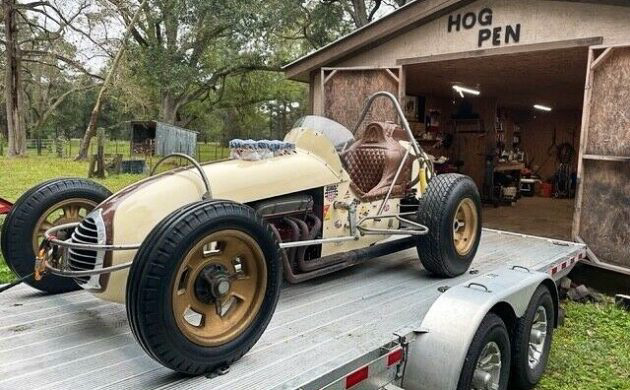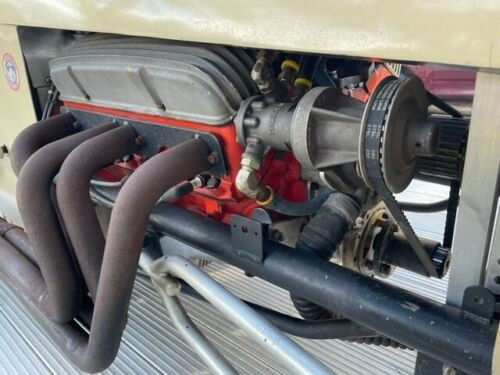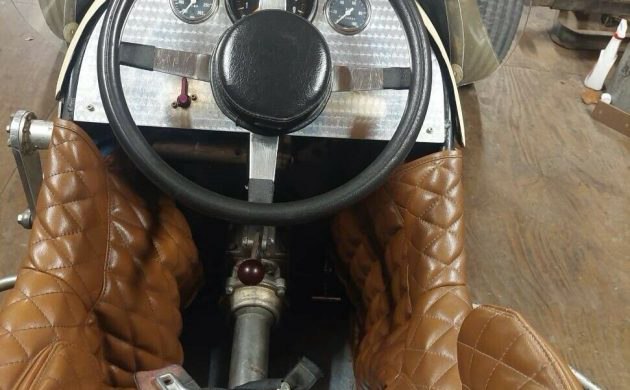A few years ago, I decided to hang up my helmet after spending my Saturday nights driving fast and turning left on dirt. My weapon of choice was a Wingless Sprint Car, and I continue to miss the experience to this day. That’s what makes cars like this 1955 Sprint Car so attractive to me. Whenever I see a vehicle like this, my hands and right foot itch as I long to slip behind the wheel and relive former glories. However, I made my decision, but I have plenty of memories of when things went wonderfully right…or horribly wrong! If you would like to experience the same sensations, this retro racer could be the ideal vehicle. Its overall condition is pretty impressive, and with low weight and a fuel-injected Chevrolet small-block under the hood, it should offer the potential for an amazing driving experience. Located in San Antonio, Texas, you will find the Sprint Car listed for sale here on eBay. The bidding has rocketed past the reserve and currently sits at $16,100. I have to say a huge thank you to Barn Finder T.J. for spotting this classic for us and helping to revive some great memories.
The basic concept of Sprint Cars has changed little over the past sixty-seven years since this vehicle was in its prime. The cars are based on a tubular steel chassis with fiberglass panels. Today, chassis manufacturers utilize 4130 Chromoly tubing for its strength and low weight, but previous generations often used regular steel tubing. I believe that is what we will find with this car, which would have been the norm in 1955. It wouldn’t pass muster in scrutineering today for regular competition, but there should be no problems for historic events. The chassis appears to be in good condition, as do the fiberglass panels. The paint shines nicely, while the signwriting and stickers appear period-correct. The rollover protection is pretty rudimentary, and modern drivers would probably look at the roll bar and shudder at the thought of what life would be like if the car suddenly went shiny side down. It appears to be rolling on a set of Halibrand knockoff wheels, which wear new tires. The rear nerf bar is the more desirable “basket” design, which is a benefit in a rear-end collision. It allows the nose of the car behind to slide under the fuel tank rather than scoring a direct hit that could result in a tank split. That’s always an excellent consideration if you’re strapped into a car with twenty gallons of methanol nestled against the small of your back!
Today’s sprint cars tip the scales at around 1,400lbs, but I’ve been unable to clarify what the minimum weight would have been in 1955. There’s little doubt that the chassis tubing would have been heavier back then, but the overall construction is less complex on the older cars, with less bar work. That leaves the potential that the weight for this car would have been about the same as for a modern alternative. When you consider that sort of weight, a V8 under the hood would always produce mind-blowing performance. In this case, we find a 327ci Chevrolet V8 that drags in its air and fuel via what appears to be a Hilborn mechanical fuel injection system. The power feeds through a manual in/out dog box to a quick-change rear end. Suspension is pretty basic, utilizing torsion bars, radius rods, and telescopic shocks to minimize weight. Modern Sprint Cars feature a purpose-built 410ci V8 that churns out more than 900hp, but even if this 327 is producing less than half that figure, it would still represent an impressive power-to-weight ratio. This is especially true when you consider the weight of the donor car that originally housed that little Chevy V8. It appears that the seller hasn’t attempted to coax the racer back to life, but the previous owner stated that it ran about two months ago. Therefore, it might be a case of the buyer performing a thorough inspection and adding fresh fuel to have that small-block roaring once again.
When I examine the interior of this retro racer, it looks positively luxurious compared to my last car. The dash appears to be machine-turned alloy and features a tachometer, oil pressure gauge, and temperature gauge. The wheel is a large diameter item to reduce steering effort. This is essential because this Sprint Car would not feature power steering. The cockpit is lined with diamond-quilted vinyl, which is in excellent condition. You can see the lever below the wheel for the in/out dog box. This feature later moved to a lever-lock to the driver’s right in modern cars, but the setup we see here is typical of the era. One non-original feature inside this car is the Simpson race belt. Drivers in the 1950s rarely used any belt or harness, believing that it was better to be thrown from the vehicle in the event of an accident. When you look at the rollover protection these vehicles provide, it’s easy to see the logic involved. Personally, I’d want to stay attached firmly to my car because once you’ve left it, that leaves you vulnerable to being run over by any following traffic. Overall, the interior appears to be period-correct and in excellent condition.
If you’ve never experienced life behind the wheel on a dirt track, it is one that is worth pursuing. There are plenty of companies and clubs that can organize a “rent-a-drive” day, but there’s nothing quite like slipping behind the wheel of your own car and taking it to the very edge. That is the experience that awaits the next owner of this 1955 Sprint Car. Retro races are experiencing growing popularity, and good examples of these cars are highly sought. This one looks like a beauty, and while it is no longer eligible for outright competition, it should still be exhilarating in the right environment. It is not a cheap toy, but sometimes we just need to treat ourselves. Do you agree?





Great write-up, Adam! I’m jealous because I never got to drive one of these, and at my age I doubt I’ll get around to it. When I was a kid, this is what sprint cars looked like, and watching them slide around the corners of a track on a Saturday night is one of my enduring memories.
My first introduction to sprint cars was at the Ohio State Fair. Long lost to my memory is the exact year, but it had to be late 50’s, or at the outside not past 1960. Most likely ’58 or ’59.
The family took a day trip from Dayton to Columbus for the Fair. I remember walking in the main gate, and some of the usual smells and sounds expected at such a venue. But after we had only been inside for an hour or so, there was a specific, much louder noise reverberating throughout the grounds. A lack of interest (and extra cash, probably) among the other 5 family members meant that we would not be going inside the fence for a real ringside seat to watch.
But I noted that when the engines’ roar was loudest, there was often a puff of dust/dirt which found its way through the nearby wood-slats wall. It was a great height for a little kid, too. With cautious pauses when dirt was being slung up against the other side, that peep-hole got a single eyeball’s worth of watching for at most half a dozen laps. Then it was of course time to go off and do other family stuff for the parents and other kids…
Cars just like this one (and by sound, some smaller engined ones at different times) were making that internal-combustion music to a young boy’s ears. More than 60 years, and I can still hear the burnt-fuel response to the drivers pushing those throttle pedals to the floor.
Heck yea.
The good old days. My father worked at Shannon Buick in Dayton for Bob and Gene Shannon (USAC HOF) in the 60s early 70’s. Something about vintage front engine race cars….works of art and sounds a turbo car just can’t match.
Shannon Buick is now Reichard, is it not?
Yes, Shannon became Reichard.
He was a salesman who worked for Shannon. Now owns other dealerships as well.
The ex-wife and I lived in Kokomo Indiana for while in the late 1980’s. My neighbor (Chrysler foundry guy) took me to the Kokomo Speedway. Great fun and very loud, amplication courtesy of huge metal warehouses at the south end of the property. There are “sweet spots” in the grandstands to avoid being pelted with mud clods and rubber. You were a King and Queen in that town if you worked at Chrysler and your wife was a Delco dolly working for GM.
Growing up in Central Pa. in the 60’s Friday and Saturday nights were spent at some dirt track, My Dad and Two Uncles drove and wrenched on these things My Uncles Boss owned 3 of them. Lived in the pits at the GROVE. If I miss anything about Pa. It’s the DIRT TRACKS I Grew Up At.
I saw my first sprint car race at Williams Grove PA about 30 years ago. I was up there for the fall Carlisle swap meet. Good Times.
Grew up in Langhorne, PA. My HS girlfriend lived about a mile from Langhorne Speedway, but I couldn’t get her to join me so went with other guys. Great track, it closed soon after I graduated.
If I could I would buy it and if all I ever got to do was sit it and pretend ,I was driving it, I would die a happy camper.
Wow do I remember sitting in dads lap and driving the his race car from grandma’s to home. I’m 63 but the memories are like we just did it yesterday.
It says here that the bidding has gone past the reserve? No, reserve not met. They have a Pinzgauer listed also.
In South Bend, In. when I was a kid I’d ride my bike to Playland Park Speedway and watch the sprint cars thru the fence, never for get the experience, also did the same for the South Bend Blue Sox, the women’s softball teams during the war, neat for a little kid
Love these Spring cars!
I mean Sprint!
RBC,
Langhorne was the best dirt track in the country until it became a shopping mall in the mid 1960’s. It was a one mile circle, not an oval, so the USAC dirt cars came by you 100 times at a 30 degree angle raining dirt on the stands. The sound of 30 255 Offy’s was something I’ll never forget. They even had a three wide start until a bad wreck on the first lap in turn two in 1959, they gave up on that for 1960. We lived in the far corner of PA, 350 miles away from Langhorne, but my parents took me there back in the day.
Everybody wore a hat, glasses, bandana, and a windbreaker that you threw in the trunk before you got in the car to leave. We had three cans of window cleaner and paper towels to clean the car windows so we could see to drive away. The dirt got every car in the parking lot. It was dirty, but great racing. Thanks for the memories.
Adam,
You miss driving the sprint car but don’t miss spending the money it costs to run it and the time it takes to maintain it and get it to the track. If I had the time I’d love to do it. But I have too many toys and not enough time.
I was really lucky growing up, my parents were race fans so I was everywhere from Indy to Daytona before I was 12. I had a go cart when I was six and Dad had the local excavator make a 1/8 mile dirt track on a vacant lot in the ‘hood, so I know the feeling you get on a dirt track. 60 years later I still want to do it, just not enough time or energy to get it done.
They used to run sprint cars at Reading Fairgrounds as well. They turned that piece of land into Fairgrounds Mall which has now been demolished. So much for progress.
I grew up around dirt tracks in Eastern PA in the late 50’s to the late 60’s. My father raced jalopies in the 50’s, then modifieds, then sprints into the 80’s. One of his big rivals was Lou Blaney, father of Dave and Dale Blaney; and grandfather of Ryan Blaney. My father was the first to have a winged sprint car at Mercer Raceway. They made it out of plywood. It was a hoot to hear the comments in the stands. But when he ran away with the race they changed their toon and cried foul.
Hello Adam,
Let me know if you still own this car. I know the history and the builder. I can share if you want some additional details